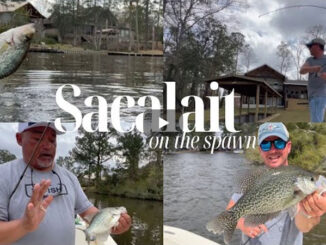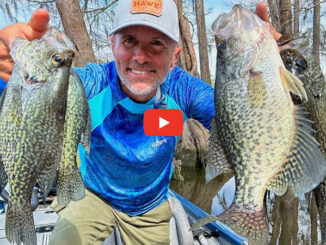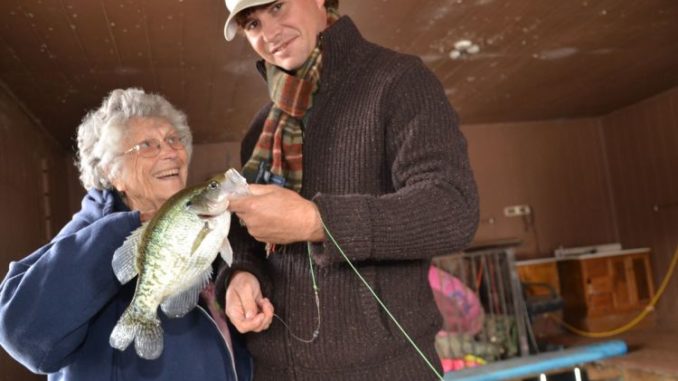
No matter what the weather is outside, crappie are almost always biting inside this fish house on Lake St. John
The voice on the telephone said, “C’mon up. Now!”
That definitely sounded like a command.
“They are biting in the fish house,” the voice said.
“Fish house? What’s that,” I asked.
“It’s kind of like a boathouse,” Josh Andrews said impatiently. “Just come up. I’ll show you.”
“My grandson is here helping me on the farm right now. I can’t just take off,” I protested.
“Bring him too. Just come on.”
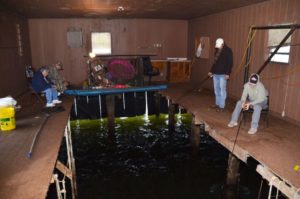
Patience obviously isn’t the 33-year-old’s long suit when the fish are biting.
So, with Jake Gros in tow, I set off for Lake St. John, the big Mississippi River-formed oxbow lake northeast of Ferriday. And my 11-year-old fish killer was overjoyed to be in on the run.
A knock on the door of the home set on the banks of the lake produced no answer, but a yell caught our attention. Andrews was waving us to come out to a nondescript, gray metal building set at the far end of a long pier.
After our eyes adjusted to the dim light inside the building, we could see that he and his two considerably older partners in crime were already busy sending white perch, as crappie are invariably called here, to meet their maker.
Bluford “Pappy” Ward, from Vidalia, is a retired heavy equipment operator. The 96-year-old is a World War II veteran who lost most of his hearing in the conflict. Fishing in a house is perfect for him.
Spunky 80-year-old Dorothy Williams, a refugee from Natchez, Miss., bought a camp on Lake St. John in 1993, six years after being widowed. “I moved here in 1995,” she said with a level gaze, “and I hope I die here — with a fishing pole in my hands.”
When she isn’t fishing, she’s picking up pecans (1,000 pounds last year with a hand-roller), tending her garden, canning vegetables and fruits, making pickles, and churning out salsa by the gallon.
And she deer hunts. “I’ll go with anybody that will take me,” she beamed. She will go on and on about the merits of different rifle calibers. It’s hard to picture her shooting a .270, but she took a trophy 10-point buck with one last season.
Andrews, her regular white perch fishing partner, lives two houses down the lakeshore, with his wife Rebecca and their two children. His specialties are hand-grabbing huge flathead catfish and whacking white perch.
The house rules
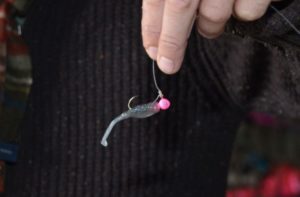
“Me and Miss Dorothy probably fish 200 out of 365 days a year,” he said in a way that didn’t invite contradiction. “That sounds like a lot, but the lake is in my backyard.
“I don’t spider rig; just single pole fish. I don’t fish shorelines much except in March when they are spawning. I fish a lot of man-made structure in open water-stake beds, rock reefs, brush piles, piers, and cypress trees standing in 8 to 12 feet of water.”
But Andrews’s and Williams’s real bread and butter for white perch fishing is the fish house. Looking just like a boat house, but without an entrance for a boat, the fish house is conveniently located off the backyard of a gone-to-seed camp located between their homes.
The camp and fish house are owned by Felicia and Brian Pilgrim, a Heidelberg, Miss. couple, who seldom use it. Felicia inherited the property from her father, a serious white perch fisherman who built it.
Felicia’s father gave Williams the key to the fish house and say-so over who uses it. The arrangement has continued under Felicia and Brian. Andrews got in on the fishing two years ago, when he bought and moved full time into his family’s camp on the lake.
Next morning over a leisurely breakfast of bacon and biscuits with tomato gravy at Williams’s home, I studied the pair more closely. In appearance, they were opposites.
Andrews was slender and athletically built, with chiseled facial features. Although Williams was much more senior than Andrews and very active, the word ‘spry’ couldn’t be used to describe her. It implied ‘elderly.’ Williams wasn’t elderly; she’s eternal.
Between bites of his biscuit, Andrews explained that they fish in the fish house almost year round, even during spawning season. “But we don’t fish in it in June, July, and August. It gets so hot.”
“I’m canning then anyway,” piped in Williams.
It wasn’t until 8 a.m. that the pair, joined by Ward and Gros, ambled down the dock to the fish house. Williams promptly took a seat on a folding chair opposite Andrews and proceeded to catch the first fish.
“Nah, nah, nah, nah, nah,” she teased Andrews.
“I believe I’m way ahead of you this year,” he retorted.
“No you ain’t. You don’t know how to count,” she shot back.
“You don’t know how to count,” mimed Andrews.
“No; you don’t,” she returned fire.
“But I’m ahead of you,” smirked Andrews.
“How can you say that? How can you say that,” asked Williams incredulously. “I’m way ahead of you today. And today is what counts.”
And this was only the first fish of the day.
House plans
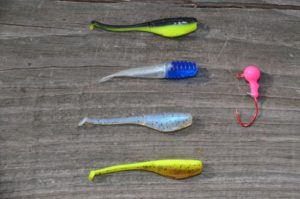
Young Gros was trying to concentrate on fishing. He didn’t know what to make of the banter between people much older than him. Besides, this indoor white perch fishing was a totally new experience.
Andrews coached him on the fine art of white perch fishing. “We have to find out how deep the fish are. We start by fishing shallow and then work our way fishing deeper. The fish will be at different depths at different times.
“A white perch is a real finicky fish. You never know what they will do. Once you find the depth you mark that.”
Andrews showed Gros how to take a measurement by touching the tip of the rod to the ceiling and then eye-balling the gap between the bait and the water.
Ten- or 12-foot jig poles are best for this kind of fishing, explained Andrews. His personal preference is for a 12-foot IM6 Double-Touch made by B’n’M.
“I have no idea what kind of pole this is,” chirped Williams, looking down at her 10-footer. “I catch them with anything. That’s a fact.”
Neither of them use jig pole reels, instead opting for ultralight spinning reels. “We catch a lot of flathead catfish on jigs,” Andrews said. “They strip out jig pole reels quickly, so that’s why we use spinning reels.”
The big flatheads were also the reason for the big-rimmed, long-handled landing net kept handy on the deck.
The small reels are spooled with 14- or 16-pound test mono. “I don’t use light line, so I can straighten a hung hook,” grunted Andrews. “Plus I don’t lose as many fish.”
Gros got into the swing of things, joining the other three in putting fish on the deck. Williams would wait until she had two or three lying at her feet before picking them up and carrying them to water-filled 5-gallon buckets.
Andrews, being Andrews, was more flamboyant. Rather than reel line in when he had a fish on, he would use his free hand to pick up as much of the slack as possible, then use the rod to swing the fish like a pendulum to the deck opposite him, near the buckets.
When the fish was over the carpeted deck he dropped it. The combination of the drop and the fish’s flipping almost always caused the hook to dislodge, allowing him to immediately deploy his jig back into the water.
Ward was a live shiner kind of guy, but the other three used jigs. None of them used corks, instead relying on feeling the bump or watching their line twitch slightly.
“Experiment with jig movement,” Andrews coached Gros. “Sometimes they don’t want it moved at all. Sometimes they want a gentle bounce. Sometimes pull it like you are trolling it. When you find what they like, fish with that technique until they quit biting.”
After 10 minutes of silence, Williams couldn’t take it anymore.
“You mad at me?”
“For what?” Andrews asked.
“For whippin’ you,” she answered.
That brought a grunt from Andrews, who is very particular about his jigs. For one thing, he doesn’t like eyes painted on his jigheads and he only uses two colors: black or pink.
Another strong preference is for sickle style hooks. “I buy the 1/32-ounce jigheads from McComb Tackle Box in McComb, Mississippi. Some guy in New Orleans pours them and they are sold in unmarked bags.”
As for the plastic, he sticks mainly with Bobby Garland products — Baby Shad Swim’Rs, Slab Slay’Rs and Baby Shads. His four favorite colors are lights out, blue pearl, monkey milk and sweet tea with lemon.
Something that really makes Andrews crazy is if someone near him has his jighead positioned wrong on the line. “The line knot needs to be set on the eye so that the whole jig is setting level (horizontal).
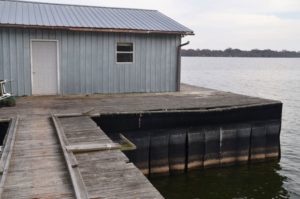
“And keep your skirt (plastic tail) pushed up on the jig,” he commanded.
As careful as he is about his jigs, Andrews cares little about scent, never using spray-ons or crappie nibbles. “Some people work hard to get human scent off baits. They wash their hands a lot. I’ve got a buddy who wears rubber gloves to pump gas to keep the scent off his hands. He don’t catch no more fish than me.”
At 10 a.m., Ward decided he was tired of catching fish and left the house. Even so, there were often two, three or four fish flopping on the deck.
In spite of the steady catches, Williams pulled Ward’s minnow bucket closer to her and cut off her jig, tying on a 1/0 gold wire hook and clamping a large split shot above it.
“Them big ones really like shiners,” she said, justifying the change.
“I guess so,” Andrews said indignantly. “The shiner does all the work.”
“Well I do all the rest,” she retorted. “I unhook ‘em and put another shiner on.
“I’m being spoiled. But that’s alright. I like being spoiled.”
“I ain’t fishing with shiners,” announced Andrews indignantly. “I have to give Miss Dorothy a chance today,” he announced, which brought loud squawks of protest from her.
She quickly hauled up a fat white perch. “Oh that’s a good one. You want a picture of it,” she asked me.
“That little thang?” snorted Andrews.
“That’s a good fish,” she protested, blue eyes twinkling. “It’s a nice one. You better put on your glasses.”
From his corner of the fishing hole, young Gros watched grinning. “It’s funny when they pick on each other,” he said to me in a low voice.
Watching her diminutive frame bounce around the fishing deck, I asked her how tall she was.
“Five feet,” she replied. “But I used to be 5’ 1.”
“Shrinking?” I asked.
“Never touched a drop in my life,” she replied
“He said shrinkin’, not drinkin’,” boomed Andrews, as if she was deaf.
The good-natured jabs and punches between the two didn’t stop.
“This is a good one,” declared Andrews as he flipped it across the fish house to Williams, who was sitting near the buckets.
“It’s a beauty,” she agreed.
“It’s better than any you caught,” declared Andrews.
“I caught some just as big,” she defended herself.
“Where’s your scale?” fired Andrews. “Did you bring the scale?”
The big white perch filled the third bucket. “I guess we better quit and get something to eat,” she lamented.
It was a few minutes after noon, and the final body count was 116 white perch and a lone yellow bass.

